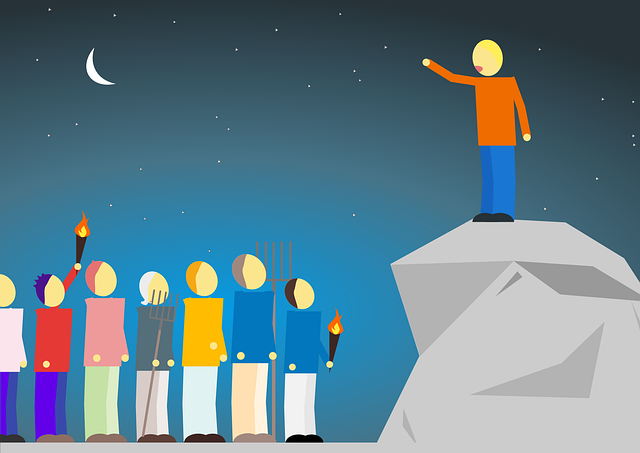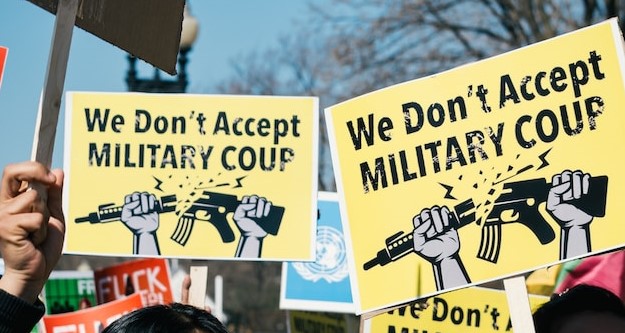An uprising is a spontaneous and often disorganized movement by a group of people to protest against the government or ruling authority, while a coup d’état is a sudden and usually violent seizure of power by a small group to overthrow and replace the existing government.
What is an uprising?
(Image by Marc Manhart from Pixabay )

An uprising is a spontaneous and often disorganized movement by a group of people to protest against or challenge the government or ruling authority. Uprisings can arise from a variety of factors, including economic hardship, political repression, social injustice, and perceived injustice or inequality. Uprisings may involve nonviolent protests, civil disobedience, or even violent clashes between protesters and security forces. The aim of an uprising is often to bring about social or political change and to establish a new order that better reflects the needs and interests of the people.
What is a Coup d’état?
(Photo by Gayatri Malhotra on Unsplash )

A coup d’état is a sudden and usually violent seizure of power by a small group, typically military officers or government officials, who overthrow the existing government and establish a new one. The coup leaders may use force or intimidation to gain political control, often with the aim of maintaining or extending the power of the ruling elite. Unlike an uprising, a coup d’état is usually well-planned and executed with military precision.
Uprising Vs. Coup d’état – Key differences
Uprising and coup d’état are two different types of political events with some key differences:
Nature and Scale: An uprising is a spontaneous and often disorganized movement by a group of people to protest against or challenge the government or ruling authority. In contrast, a coup d’état is a well-planned and executed event, typically by military officers or government officials, who aim to overthrow the existing government and establish a new one.
Level of Violence: Uprisings can involve nonviolent protests, civil disobedience, or even violent clashes between protesters and security forces. However, the level of violence is generally lower than in a coup d’état, which often involves military force and violence.
Goal and Aim: The primary goal of an uprising is to bring about social or political change and to establish a new order that better reflects the needs and interests of the people. In contrast, the primary aim of a coup d’état is to gain political control, often through force or intimidation, and to maintain or extend the power of the ruling elite.
Participation: Uprisings typically involve a larger number of people from different backgrounds and social classes who share a common goal of change. In contrast, a coup d’état is typically orchestrated by a small group of individuals who hold significant power in the government or military.
Legitimacy: Uprisings are often seen as a legitimate form of political expression, especially in democratic societies, and may even result in political reforms. In contrast, coup d’états are generally regarded as illegal and undemocratic, as they involve the use of force to seize power.
The key differences between an uprising and a coup d’état are their nature, level of violence, goal and aim, participation, and legitimacy.
Examples of Uprising and Coup d’état
While an uprising is a revolt against an established government, a coup d’état is a takeover of the government by a small group. In some cases, such as the Russian Revolution of 1917, an uprising can lead to a coup. Here are some other examples of uprisings and coups:
- The French Revolution of 1789 was an uprising against the monarchy that eventually led to the establishment of the French Republic.
- The 1848 revolutions were a series of uprisings across Europe that unsuccessfully attempted to overthrow various monarchies.
- In 1953, the Iranian people rose up against the Shah’s dictatorship in what became known as the Iranian Revolution. This eventually led to the establishment of the Islamic Republic of Iran.
- In 1973, a military coup overthrew democratically elected Chilean President Salvador Allende, leading to years of dictatorship under Augusto Pinochet.
What are some famous Coup d’état’s in history?
There have been numerous coup d’états throughout history. Here are some examples of famous coup d’états:
- October Revolution (1917) – A coup d’état led by the Bolshevik Party, which overthrew the Provisional Government of Russia and established the first communist government in the world.
- Chilean coup d’état (1973) – A military coup led by General Augusto Pinochet, which overthrew the democratically elected socialist government of President Salvador Allende and established a military dictatorship that lasted for 17 years.
- Iranian coup d’état (1953) – A coup d’état orchestrated by the United States and the United Kingdom, which overthrew the democratically elected government of Prime Minister Mohammad Mossadegh and reinstated the Shah of Iran.
- Egyptian coup d’état (2013) – A coup d’état led by the Egyptian military, which overthrew the democratically elected government of President Mohamed Morsi.
- Burkinabé coup d’état (2014) – A coup d’état led by the military in Burkina Faso, which overthrew the government of President Blaise Compaoré.
- Nigerian coup d’état (1966) – A coup d’état led by a group of Nigerian army officers, which overthrew the government of Prime Minister Sir Abubakar Tafawa Balewa and established a military government.
- Haitian coup d’état (1991) – A coup d’état led by General Raoul Cédras, which overthrew the democratically elected government of President Jean-Bertrand Aristide.
These are just a few examples of some famous coup d’états in history, and there are many more.
What are some famous uprisings in history?
There have been many famous uprisings in history, here are some examples:
- The French Revolution (1789-1799) – A major uprising in France against the monarchy, which led to the overthrow of the king and the establishment of a republic.
- The Indian Rebellion (1857-1858) – A major uprising against British colonial rule in India, which was sparked by a mutiny by Indian soldiers in the British army.
- The Boxer Rebellion (1899-1901) – An anti-foreigner and anti-Christian uprising in China, which was led by a secret society known as the Boxers.
- The Easter Rising (1916) – A rebellion against British rule in Ireland, which was led by Irish nationalists seeking independence for Ireland.
- The Soweto Uprising (1976) – A series of protests and demonstrations against apartheid in South Africa, which were led by black students in the township of Soweto.
- The Arab Spring (2010-2012) – A series of uprisings and protests against authoritarian regimes in the Middle East and North Africa, which were sparked by the self-immolation of a Tunisian street vendor.
These are just a few examples of famous uprisings in history, and there are many more.
The reason for uprisings and Coup d’états
Uprisings and coup d’états can be motivated by various factors, including political, economic, and social grievances. Here are some common reasons for these events:
Political oppression: Uprisings and coup d’états can occur when the government is seen as oppressive, corrupt, or authoritarian. The people may rise up to demand greater political freedom, civil liberties, and democratic rights.
Economic hardship: Economic factors such as poverty, inequality, unemployment, and inflation can also motivate uprisings and coup d’états. The people may be discontented with the government’s economic policies and demand greater opportunities for economic growth and social mobility.
Social inequality: Social factors such as discrimination, marginalization, and exclusion can also contribute to uprisings and coup d’états. The people may be fighting for greater social justice, equality, and representation.
Foreign interference: Uprisings and coup d’états can also be motivated by foreign interference, where external powers seek to influence or manipulate the domestic politics of a country for their own interests.
These are just some of the reasons why uprisings and coup d’états can occur. The specific causes can vary depending on the context and historical circumstances of each event.
Featured Image By – Gerd Altmann from Pixabay








